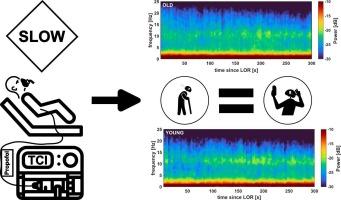战胜年龄:缓慢麻醉诱导可防止老年患者出现爆发抑制,并有助于形成年轻大脑的术中脑电图特征
IF 5
2区 医学
Q1 ANESTHESIOLOGY
引用次数: 0
摘要
老年患者术后容易出现神经认知功能障碍,这可能是麻醉管理不当造成的。为了研究在脑电图指导下进行个体化麻醉滴定的潜力,我们评估了患者年龄对异丙酚缓慢诱导过程中脑电图频谱组成的影响。26 名年轻患者(65 岁)和 25 名老年患者(≥65 岁)接受异丙酚治疗,直至失去反应性(LOR)。反应消失后,我们将基于流速的输注模式切换为目标控制输注模式,以保持反应消失时计算出的效应部位浓度稳定。我们记录了额叶脑电图,并计算了功率谱密度(PSD)和频带功率。为了比较老年患者和年轻患者的频谱组成,我们使用了效应大小,即接收者操作特征曲线下的面积。没有患者出现爆发抑制模式。虽然所有频段的绝对功率都随着患者年龄的增长而明显下降,但在整个延长的诱导期,频谱组成并没有发生变化。慢速麻醉诱导可能是一种适合老年患者的方法,它可以保留通常在年轻大脑中发现的频谱组成模式,并单独确定麻醉需求,从而降低过度麻醉效应的风险。本文章由计算机程序翻译,如有差异,请以英文原文为准。

Overcoming age: Slow anesthesia induction may prevent geriatric patients from developing burst suppression and help developing intraoperative EEG signatures of a younger brain
Elderly patients are prone to develop postoperative neurocognitive deficits potentially precipitated by inadequate anesthetic management. To investigate the potential of EEG-guided individualized anesthetic titration we evaluated the effect of the patient's age on the spectral composition of the EEG during slow propofol induction.
Twenty-six young (<65 years) and 25 old (≥65 years) patients received propofol until loss of responsiveness (LOR). After LOR, we switched from a flow rate-based to a target-controlled infusion mode keeping the calculated effect-site concentration at LOR stable. We recorded a frontal EEG and calculated the power spectral density (PSD) and the band powers. For the comparison of the spectral composition of old and young patients, we used an effect size, the area under the receiver operating characteristic curve.
The older patients received significantly less propofol (p < 0.001). No patient showed a burst suppression pattern. Whereas the absolute power in all frequency bands decreased significantly with the patient's age, the spectral composition did not change throughout the extended induction period.
Slow anesthesia induction may be a suitable approach for geriatric patients to preserve spectral composition patterns typically found in younger brains and to individually identify anesthetic requirements reducing the risk of excessive anesthetic effects.
求助全文
通过发布文献求助,成功后即可免费获取论文全文。
去求助
来源期刊
CiteScore
7.40
自引率
4.50%
发文量
346
审稿时长
23 days
期刊介绍:
The Journal of Clinical Anesthesia (JCA) addresses all aspects of anesthesia practice, including anesthetic administration, pharmacokinetics, preoperative and postoperative considerations, coexisting disease and other complicating factors, cost issues, and similar concerns anesthesiologists contend with daily. Exceptionally high standards of presentation and accuracy are maintained.
The core of the journal is original contributions on subjects relevant to clinical practice, and rigorously peer-reviewed. Highly respected international experts have joined together to form the Editorial Board, sharing their years of experience and clinical expertise. Specialized section editors cover the various subspecialties within the field. To keep your practical clinical skills current, the journal bridges the gap between the laboratory and the clinical practice of anesthesiology and critical care to clarify how new insights can improve daily practice.

 求助内容:
求助内容: 应助结果提醒方式:
应助结果提醒方式:


